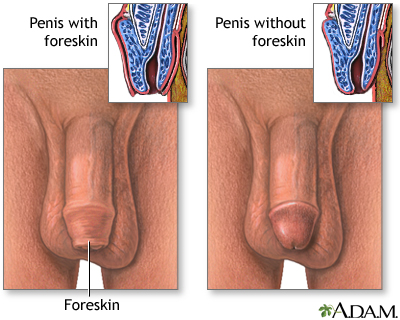Paraphimosis
Paraphimosis occurs when the foreskin of an uncircumcised male cannot be pulled back over the head of the penis.
Images

I Would Like to Learn About:
Causes
Causes of paraphimosis include:
- Injury to the penis.
- Failure to return the foreskin to its normal location after urination or washing. This is more common in hospitals and nursing homes.
- Infection, which may be due to not washing the area well.
Men who have not been circumcised and those who may not have been correctly circumcised are at risk.
Paraphimosis occurs most often in boys and older men.
Symptoms
The foreskin is pulled back (retracted) behind the rounded tip of the penis (glans) and stays there. The retracted foreskin and glans become swollen. This makes it difficult to return the foreskin to its extended position.
Symptoms include:
- Inability to pull the retracted foreskin forward over the head of the penis
- Painful swelling at the end of the penis
- Pain in the penis
Exams and Tests
A physical exam confirms the diagnosis. The health care provider will usually find a "doughnut" around the shaft near the head of the penis (glans).
Treatment
Pressing on the head of the penis while pushing the foreskin forward may reduce the swelling. If this fails, prompt surgical circumcision or other surgery to relieve swelling will be needed.
Outlook (Prognosis)
The outcome is likely to be excellent if the condition is diagnosed and treated quickly.
Possible Complications
If paraphimosis is left untreated, it can disrupt blood flow to the tip of the penis. In extreme (and rare) cases, this may lead to:
- Damage to the penis tip
- Gangrene
- Loss of the penis tip
When to Contact a Medical Professional
Go to your local emergency room if this occurs.
Prevention
Returning the foreskin to its normal position after pulling it back may help prevent this condition.
Circumcision, when done correctly, prevents this condition.
References
Boswell B, Thomas AA. Pediatric genitourinary and renal tract disorders. In: Walls RM, ed. Rosen’s Emergency Medicine: Concepts and Clinical Practice. 10th ed. Philadelphia, PA: Elsevier; 2023:chap 168.
Elder JS. Anomalies of the penis and urethra. In: Kliegman RM, St. Geme JW, Blum NJ, Shah SS, Tasker RC, Wilson KM, eds. Nelson Textbook of Pediatrics. 21st ed. Philadelphia, PA: Elsevier; 2020:chap 559.
Virasoro R, Jordan GH, McCammon KA. Surgery for benign disorders of the penis and urethra. In: Partin AW, Domochowski RR, Kavoussi LR, Peters CA, eds. Campbell-Walsh-Wein Urology. 12th ed. Philadelphia, PA: Elsevier; 2021:chap 82.
BACK TO TOPReview Date: 1/1/2023
Reviewed By: Kelly L. Stratton, MD, FACS, Associate Professor, Department of Urology, University of Oklahoma Health Sciences Center, Oklahoma City, OK. Also reviewed by David C. Dugdale, MD, Medical Director, Brenda Conaway, Editorial Director, and the A.D.A.M. Editorial team.

Health Content Provider
06/01/2025
|
A.D.A.M., Inc. is accredited by URAC, for Health Content Provider (www.urac.org). URAC's accreditation program is an independent audit to verify that A.D.A.M. follows rigorous standards of quality and accountability. A.D.A.M. is among the first to achieve this important distinction for online health information and services. Learn more about A.D.A.M.'s editorial policy, editorial process and privacy policy. A.D.A.M. is also a founding member of Hi-Ethics. This site complied with the HONcode standard for trustworthy health information from 1995 to 2022, after which HON (Health On the Net, a not-for-profit organization that promoted transparent and reliable health information online) was discontinued. |
The information provided herein should not be used during any medical emergency or for the diagnosis or treatment of any medical condition. A licensed medical professional should be consulted for diagnosis and treatment of any and all medical conditions. Links to other sites are provided for information only -- they do not constitute endorsements of those other sites. © 1997- 2024 A.D.A.M., a business unit of Ebix, Inc. Any duplication or distribution of the information contained herein is strictly prohibited.
